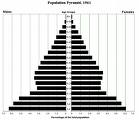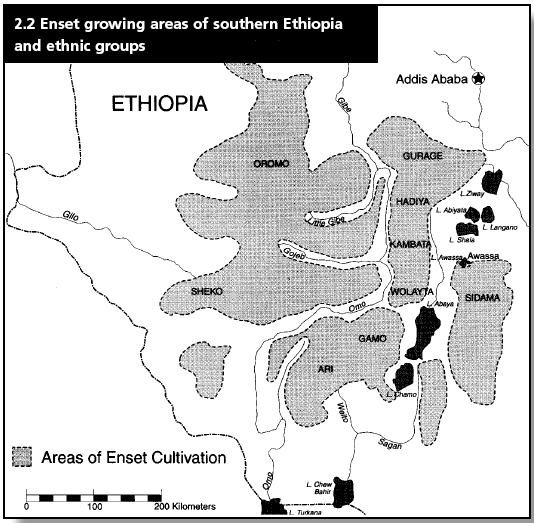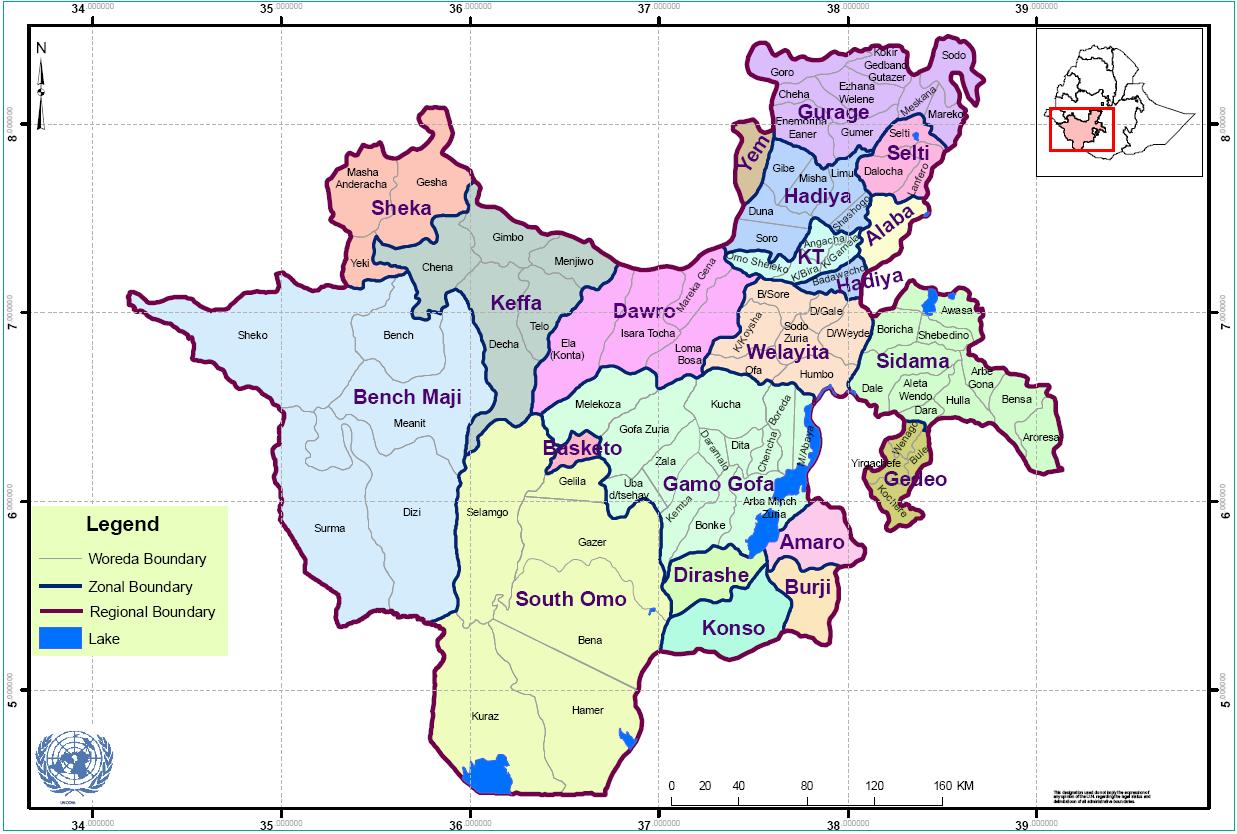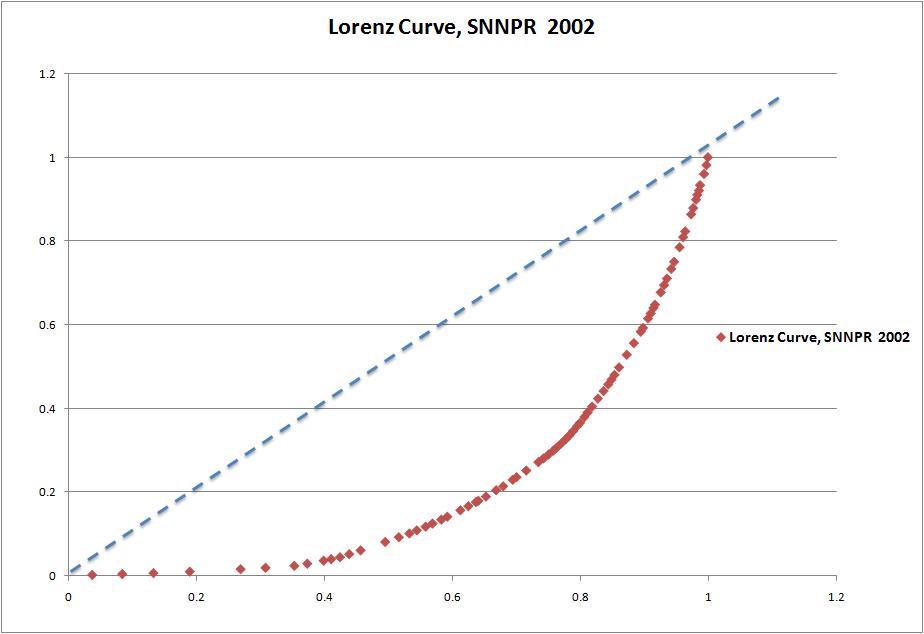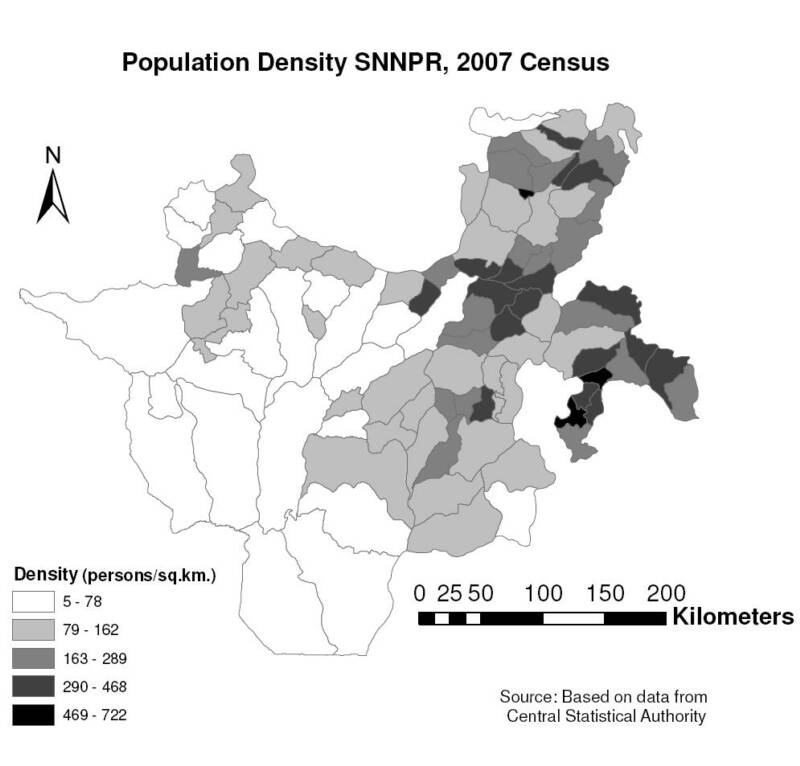Ethiopian Demography and Health
SNNPR is one of the largest regions in Ethiopia, accounting for more than 10 percent of the country’s land area [1] and an estimated population of 20,768,000 (May 2018) almost a fifth of the country’s population. The mid-2008 population was estimated at 16 million. With less than one in tenth of its population (8.9%) living in urban areas in 2008 the region is overwhelmingly rural. "The SNNPR region is divided into 13 administrative zones, 133 Woredas and 3512 Kebeles, and its capital is Awassa." [1]
"The SNNPR is an extremely ethnically diverse region of Ethiopia, inhabited by more than 80 ethnic groups, of which over 45 (or 56 percent) are indigenous to the region (CSA 1996). These ethnic groups are distinguished by different languages, cultures, and socioeconomic organizations. Although none of the indigenous ethnic groups dominates the ethnic makeup of the national population, there is a considerable ethnic imbalance within the region. The largest ethnic groups in the SNNPR are the Sidama (17.6 percent), Wolayta (11.7 percent), Gurage (8.8 percent), Hadiya (8.4 percent), Selite (7.1 percent), Gamo (6.7 percent), Keffa (5.3 percent), Gedeo (4.4 percent), and Kembata (4.3 percent) (Table 3.1). While the Sidama are the largest ethnic group in the region, each ethnic group is numerically dominant in its respective administrative zone, and there are large minority ethnic groups in each zone. The languages spoken in the SNNPR can be classified into four linguistic families: Cushitic, Nilotic, Omotic, and Semitic. The majority of the ethnic groups in the region are from the family of Omotic language, and ethnic groups belonging to the Nilotic language family are mostly minority. Among the largest ethnic groups, the Gaino, Goffa, and Wolayta are members of the Omotic linguistic family. While the Hadiya, Kembata, and Sidama are from the Cushitic linguistic group, the Gurage and Amhara belong to the Semitic language family ...." [2]
Ethnic Groups
The following paragraphs are based on online entries regarding the major ethnic groups in SNNPR and their way of life [3] as well as other related sources.
The Basketo: Are ensete growers with additional cultivation of maize, tuber roots, millet and vegetables. "They also keep domestic animals in small numbers". "Traditionally, the Basketo were organized as a segmentary clan society headed by a divine king, the kati. The ethnic religion of the Basketo knew a duality of the sky-god Tsosii and the earth-mother Qacharunde. Under Ethiopian rule they mostly adopted Ethiopian Orthodox Christianity. Their homeland became part of the expanding territory in 1893 [3].
The Daasanach: Occupy territories in Ethiopia, Kenya and the Sudan their main homeland being the Debub Omo Zone surronding the North end of Lake Turkana. Though traditionally pastoral, the Daasanach have in recent years become primarily agropastoral. Having been dispossessed of "...their traditional Kenyan lands, including on both sides of Lake Turkana, and the 'Ilemi Triangle' of Sudan, they have suffered a massive decrease in the numbers of cattle, goats and sheep". As a result, large numbers have relocated closer to the Omo, as settled agriculturalists. Tropical vectored diseases are widespread including trypanosomiasis transmitted by the tsetse bite. The Daasanach are knwn to be highly egalitarian "....with a social system involving age sets and clan lineages - both of which involve strong reciprocity...." [3]
"The Daasanach language is a Cushitic language, notable for its large number of noun classes, irregular verb system, and implosive consonants (for instance, the initial D in Daasanach is implosive, sometimes written as 'D)." [3]
The Dorze: The Dorze ".... live primarily in the southern region of the country, though some have migrated to Addis Ababa and other regions". A significant number live in villages near the cities of Chencha and Arba Minch, located in the Semien Omo Zone (formerly in the Gamu-Gofa province). "Weaving is a primary profession for many Dorze." . The Dorze practice a system of cultivation based on ingenious terracing of the mountainsides and around their huge bee-hive-like huts they tend small gardens with vegetables, spices, enset and also tobacco. [4]. In the words of an intreagued visitor to the region:
"The Dorze people are famous for their huge huts, resembling a giant beehive. Although these huts look fragile, they can last up to 60 years. The huts can also be transported to another locations, thanks to the structure made of vertical poles. Every hut hat a sort of ''nose'' at its south side, serving as reception room. After our eyes were accustomed at the rather darkness, coming from the full sunlight, it was interesting to see the construction of the hut from the inside. It’s surprising the large space in the hut when outside it looked so small. In the middle of the hut there is an open fire for cooking. There are also low benches to sit around the fire. Along the walls are located sleeping places and places for storage. " [4]
The Gurage: "....inhabit a semi-fertile, semi-mountainous region in southwest Ethiopia, about 150 miles southwest of Addis Ababa. Their homeland extends to the Awash River in the north, the Gibe River (a tributary of the Omo) to the southwest, and to Lake Zway in the east." Three distinct regional entities form the Gurage ethnic group - Northern, Eastern and Western. However the largest of them all - the Eastern subgroup, known as the Silt'e - have, traditionally, not considered themselves to be Gurage, and "in a referendum in 2000 they voted unanimously to break away from the Gurage Zone within the Southern Nations, Nationalities, and Peoples Region, forming their own autonomous region" [3]
"According to the historian Paul B. Henze, their origins are explained by traditions of a military expedition to the south during the last years of the Axumite Kingdom which left military colonies that eventually became isolated from both northern Ethiopia and each other" [3]. The majority of Gurages are Orthodox christians, and another 40 % are moslem. According to the 1994 cnesus people self-identifying as Gurage constituted about 4.3 % of the total Ethiopia's population.
The Gurage are sedentary agriculturalists practicing "a complex system of crop rotation and transplanting. Ensete is their main staple crop, but other cash crops are grown, which include coffee and chat. Animal husbandry is practiced, but mainly for milk supply and dung. Other foods consumed include green cabbage, cheese, butter, and roasted grains, with meat consumption being very limited. The Gurage, the writer Nega Mezlekia notes, 'have earned a reputation as skilled traders' " [3].
"Well-known for their hard work and skill as traders, many of the men own shops in Addis Ababa and other cities, returning to their home area only for a few days each October to celebrate Meskel (for Orthodox Christians - commemorating the finding of "the true cross") or Arefa (for Muslims), the most important Gurage holidays....Gurage houses are famous for their neatness and symmetry, circular structures held together without the use of nails, wooden spokes protruding from a center pole to support the thatched roof. Locally-made pottery hangs around the inside wall in neat rows. Near the center is a fireplace used for cooking and heating the house. The people take pride in their hospitality and often serve coffee (boiled in a large clay pot and traditionally flavored with salt and butter) and roasted grain to 30 or more guests at a time. This provides socialization for neighbors and refreshment for passers-by. Often a small section on one side of the house is equipped for livestock (cows, sheep or goats, and perhaps a horse), which are kept in the house during the night and put out to pasture in the daytime." [5]
The Hadiya: "From the 13th to the 16th centuries the Hadiyya constituted one of the most important political entities of Northeast Africa." [6] Their contiguous territorial block of settled agricultural life was then shattered by invading forces and its inhabitants were absorbed into other peoples of heterogeneous ethnic stock. "At present, descendants of the old Hadiyya can be identified in five different linguistic clusters: the Hadiyya proper, to which they themselves, however, object. Their subtribes, the Maarako, Leemo/Baadoogo, Sooro, Shaashoogo, and Baadawwaacco, occupy a territory between Lake Zway and the river Omo (Gibe)" [6].
Hammer: "The Hammer (also spelled Hamar) are a tribal people in southwestern Ethiopia. They live in Hamer Bena woreda (or district), a fertile part of the Omo River valley, in the Debub Omo Zone of the Southern Nations, Nationalities, and Peoples Region" [3]. The hammer are largely pastoralists and place a significant value on cattle. Based on the 1994 census the Central Statistical Authority estimated the population of the Hammer language speakers at 42,838 out of a total population of about 53 million or about 0.1% of the population [3]. Regarding the education level of the Hammer "The Assistant Administrator of Hammer Bena Ato Imnet Gashab has commented that only six tribal members have ever completed secondary education" [3]
Sidama: The Sidama speak a language called Sidaamu-afoo. The majorityare adherents of native African religions, some are born-again Christians, a few are Orthodox Christians and a very small proportion are Muslim.
Historically, there were Sidama kingdoms in the Gibe region. "Nearly 95% of the Sidama live a life centered around agriculture. An important staple food is the wesse plant, or Ensete. Other crops are also grown and they breed cattle. An important source of income is coffee. An economic importance of the Sidama, coffee is immense and it contributes a high percentage of export coffee for the central government, only second to the Oromia region. The Sidama farmers were affected by hunger caused by sinking world market prices for coffee, despite supplying the popular coffee chain Starbuck's with the majority of their coffee products from the region.(coffee crisis according to the pretext of Central the government)" [3]
Silte: The Silte are a Muslim people who saw their homeland being incorporated into the Modern Ethiopian State in the late 19th century. They have emerged as part of the Gurage (a group recognized as the most industrious ethnic group) by other Ethiopian nationals. More recently, however, they were accorded a "nationality" status under the federal state system and have been were recognized by the ruling party as the “Silte Nationality” distinct from the Gurage. "It is believed that the origin of the Silte dates back to the 16th century, when Imam Ahmad ibn Ibrahim (or “Ahmad Gran” in the context of Abyssinian history) conducted a massive military expedition against Christian Abyssinia. According to the Silte oral tradition, a religious leader called Hajj Aliye who was born in Harar followed the expedition until he was asked to settle in a place called Umnan. He married with local women, and his last son called Gan-Silte is believed to be the ancestor of the Silte." [10] Later, warfare over land and water rights was a common occurence between the Silte and the surrounding groups (Sebat Bet, Kistaneand Arsi Oromo) before the end of 19th century.... By the 1930’s, the Silte were playing important roles in Sidama coffee markets and established the trade route up to Addis Abeba" [10].
Welayita:
Welayita Sodo is located about 400 kilo meters south west of Addis Ababa at 6° 49' N latitude and 39° 47' E longitude and at an altitude of about 1900 m. "The area has moderately drained, acidic red soils (nitosols). The average monthly temperature in the area ranges between 11.9°C (August) and 26.2°C (January) with a mean annual temperature of 18.9°C. Rainfall averages 1100 mm a year and is bimodal, with the short rains from February or March until April and the long rains from June until September or October" [11]. Land-use is very intensive with a cropping cropping adopted to maximize yield. Intercropping is practiced commonly. "Major food crops include, in order of importance, maize, sweet potato, enset (false banana), teff (Eragrostis tef), haricot bean, taro, sorghum, Irish potato, yam and cassava. The main cash crop is coffee. "Some farmers use chemical fertiliser, mainly diammonium phosphate, on food crops such as teff and maize." [11]
"About 93% of the farmers are engaged in livestock production in addition to cropping. The average livestock holding per household is 3.60 cattle, 0.74 sheep, 0.25 goats, 0.13 donkeys, 0.02 mules, 0.02 horses and 2.09 poultry. The predominant breed of cattle is the local zebu. Animal manure is applied on garden crops; livestock also provide draught power for important farm operations. Crop residues are mainly used as dry-season feed for livestock. It seems that there is a strong positive interaction between crop and livestock production. This paper, therefore, attempts to assess this complementarily and the prospects for further integration of food and feed production in Welayita Sodo." [11]
Agriculture in SNNPR
"SNNPR boasts all of the inhabited environments seen elsewhere in Ethiopia: arable highlands (dega), midlands (woina dega) and lowlands (kolla), and pastoral rangelands (bereha). But the most characteristic environment of the Region is a relatively fertile and humid midland which contains the densest rural populations of Ethiopia. The majority of woredas have more than 100 people per square kilometre, many have over 200 ppkm2, several over 300 ppkm2 and one, Wenago in Gedeo Administrative Zone, as many as 600 ppkm2.
The most characteristic product of SNNPR is enset, a food unique to Ethiopia, and in modern times at least, largely confined to southern Ethiopia as a staple. Enset (Ensete ventricosum) is sometimes called ‘False Banana’ because its leaves are so similar to those of the banana plants to which it is related; but it is the starchy base of the plant – the corm and the leaf-sheaths – which provides the foodstuff. This is eaten in various forms: boiled corm (amicho), or a fermented product in the form of a bread (kocho), or the best-quality product from mature plants (bulla) in the form of pancakes, porridge or dumplings. Enset may be planted in clusters around the compound, or in dense fields. As a perennial, maturing at around four years and grown up to seven years, enset acts as a food store which can be used at any time of year; it is a relatively drought-resistant plant, and the leaves provide fodder for livestock as well as twine for rope-making. However, enset is virtually never the sole food-source of households and is rarely their chief marketed item. Cereals are
ubiquitous, and are dominant in relatively high- or low-altitude arable areas, together with smaller amounts of ulses and oilseeds. Annual root crops are important especially in midland areas, and include sweet potatoes, Irish potatoes, taro and cassava – the last of which may also be a perennial. But the varied ecologies of SNNPR also offer greater or SNNPR Livelihood Profiles Regional Overview December 2005 Regional Overview 9 lesser niche areas for important cash-crops, of which the biggest is coffee." [7]
Additionally, important cash crops such as ginger, chilli peppers, and the mild stimulant drug leaf chat (Catha edulis) hare grown and traded to raise supplimentary cash. Honey from the lowlands, and a localized banana production on irrigated plots also add to the mix of income generating crops "... whilst the cardamom-like spice aframomum is a still more localized product (notably in Basketo Melo Coffee Livelihood Zone), as are wild spices from the forests of the far west of the Region where honey is also collected" [9]. Urban buliding activities have spurred a spike in demand for Eucalyptus logs widely marketed for use as scaffolding. "Finally there are livestock, not only amongst pastoral groups in the rangelands of the south-west, but in crowded agricultural areas where cattle are often hand-fed, and butter is an important marketed item, and oxen are fattened for the meat market." [9].
References:
1. http://www.rippleethiopia.org/page/snnpr
http://www.rippleethiopia.org/page/snnpr
2. Dennis P. Hogan and Betemariam Berhanu. Social Identity and Community in the Fertility of
Dennis P. Hogan and Betemariam Berhanu. Social Identity and Community in the Fertility of
southern Ethiopian Women, in Samuel Agyei-Mensah and John B. Casterline. (eds.)
Reproduction and social context in sub-Saharan Africa. 2003.
3. http://en.wikipedia.org/wiki/Southern_Nations,_Nationalities,_and_People's_Region
http://en.wikipedia.org/wiki/Southern_Nations,_Nationalities,_and_People's_Region
4. http://www.pbase.com/sergio_pes/dorze_people
http://www.pbase.com/sergio_pes/dorze_people
5. Southern Nations,Nationalities, and Peoples Region (SNNPR LIVELIHOOD PROFILE), Regional
Southern Nations,Nationalities, and Peoples Region (SNNPR LIVELIHOOD PROFILE), Regional
Overview. FEWSNET, USAID, Disaster Prevention and Preparedness Commission (DPPC), the
Government of Ethiopia. December 2005.
6. http://www.sethiopia.org/se/index.php?&MMN_position=1:1
http://www.sethiopia.org/se/index.php?&MMN_position=1:1
7. http://www.carolynford.org/gurage/index.shtml
http://www.carolynford.org/gurage/index.shtml
8. Steven A. Brandt et.al. The “Tree Against Hunger” Enset-Based Agricultural Systems in Ethiopia. American
Steven A. Brandt et.al. The “Tree Against Hunger” Enset-Based Agricultural Systems in Ethiopia. American
9. Southern Nations Nationalities and People’s Region (SNNPR) LIVELIHOOD PROFILES. Regional Overview.
Southern Nations Nationalities and People’s Region (SNNPR) LIVELIHOOD PROFILES. Regional Overview.
USAID
10. Makoto NISHI. Making and Unmaking of the Nation-state and Ethnicity in Modern Ethiopia: A study on the History
of the Silte People. African Study Monographs, Suppl. 29: 157-168, March 2005
11. http://www.fao.org/wairdocs/ILRI/x5519B/x5519b19.htm
12. http://www.csa.gov.et/text_files/national%20statistics%202006/Population.pdf
13. Central Statistical Authority, 2001, Statistical Abstract pp. 26 - 4
14. Ethiopia Demographic and Health Survey 2005 Central Statistical Agency, Addis Ababa, Ethiopia ,
RC Macro, Calverton, Maryland, USA, September 2006
Source: [8]
Population Distribution
The most densily populated Wereda in Ethiopia - Wenago - with nearly a 1000 people per square kilometers, is located in SNNPR. The intense population concentration here can also be noted from the distribution of high density Weredas of over 500 people per square kilometers. SNNPR has ten of these in addition to Wenago - Damot Gale, Aleta Wendo, Yirgachefe. Dara, Kacha Bira, Sodo Zuria, Angacha, Shebedino, Kedida Gamela and Boloso Sore. Four other Weredas - Awasa, Badawacho, Gumer, and Kochere - have a density of over 400 (see map below).
Two thirds of the 75 Weredas listed have a density of over 100 persons per sqare kilometers, an obseravion not duplicate anywhere else in the country. There are low density Weredas too, confirming the unevenness of the population distribution here, a fact graphically captured by the Lorenz Curve (below) calculated and drawn for this region (go back to the main page and click on "calculate demographic rates" to learn about Lorenz Curve construction). In terms of population totals, the highest population sizes are in Shebedino (over half a million people) and Awasa (450,000 people) and seven other Weredas where the population is over 300,000 - Dale, Limo, Soro, Konteb, Aleta Wendo, Boloso Sore and Gumer.
SNNP Weredas Ranked by Population Density
Source: [12]
Demographic Characteristics
The following table provides a brief glimpse into the socio-demographics characteristics of the SNNP featuring the the variables listed below [14]:
• Household and respondent characteristics
• Fertility levels and preferences
• Knowledge and use of family planning
• Childhood mortality
• Maternity care
• Childhood illness, treatment, and preventative actions
• Anaemia levels among women and children
• Breastfeeding practices
• Nutritional status of women and young children
• Malaria prevention and treatment
• Marriage and sexual activity
• Awareness and behaviour regarding AIDS and STIs
• Harmful traditional practices
Source: [13]
If you would like to help update this page, please send comments and/or data (as an e-mail attachment) to Dr. Aynalem Adugna
at aynalemadugna@aol.com. Don't forget to indicate sources.
